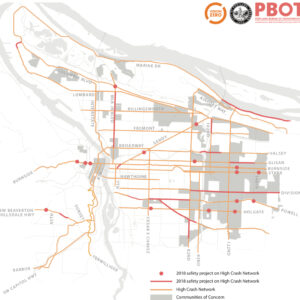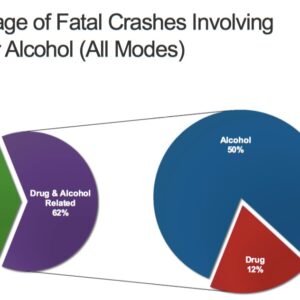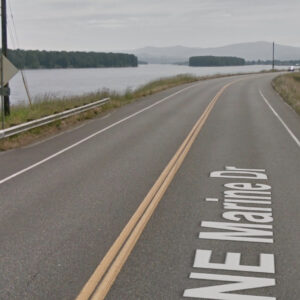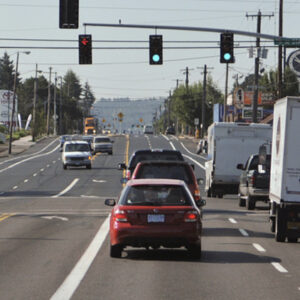
The City of Portland is on a steady march toward safer streets through their Vision Zero program. Yesterday the Bureau of Transportation announced details of 18 “High Crash Network” streets that will get a range of safety updates in 2019.
It’s all in service to our adopted goal of ending traffic violence in the next six years.
The list includes four larger, multi-block projects (marked with asterisk below) and 14 “targeted” fixes on 14 other streets (click street name for project page):
*102nd: a pilot project will evaluate the safety impact of additional crossings, bike lanes, and safer speeds between Weidler and Sandy.
*Capitol Hwy: extensive updates are planned between Garden Home and Taylors Ferry, while more modest (but important!) safety fixes are planned from Huber to Kerr Parkway.
*Marine Dr: safety fixes from 33rd to 185th include new bike lanes, rumble strips, rapid flashing beacons, and a traffic signal at 122nd.
*Powell Blvd: new crosswalks, rapid flashing beacons, sidewalks, protected bike lanes, center turn lanes, lighting, and drainage are planned from 122nd to 136th.
92nd: upgrade signal hardware at Holgate
122nd: larger signal heads & reflective backboards (Airport Way-Burnside), bike lane extensions and conflict markings at 11 intersections (Halsey-Holgate), crossing enhancement at I-84 underpass
Barbur: sidewalk infill, enhanced crossings, rebuilt bike/ped connection (Lane, 53rd)
Broadway: larger signal heads & reflective backboards (Larrabee-Chávez), bike lane extensions and conflict markings (Irving-Oak)
Burnside, East: crossing enhancements at 16th, 129th
Burnside, West: crossing enhancements at 20th PlaceAdvertisement
Columbia: new bridge for walking & biking (Chimney Park), crossing improvements at Midway, intersection safety fixes at Cully/Alderwood
Division: larger signal heads & reflective backboards (21st-162nd), lighting (122nd-129th), crossing enhancements (64th, 77th, 78th), enhanced bike lanes, more lighting, and improved crossings (82nd-city limit)
Glisan: crossing enhancements at 108th, 128th, and 155th
Halsey: larger signal heads & reflective backboards (84th), two-way bike lanes on I-205 overpass, more lighting, enhanced crossings, protected bike lanes, and speed limit reduction (103rd-116th), sidewalk infill (114th162nd), enhanced crossings (119th, 128th, 143rd, 155th)
Holgate: larger signal heads & reflective backboards (17th-92nd), crossing enhancements (67th, 78th, 79th, 112th, 128th), sidewalk infill (102nd-122nd)
Killingsworth: sidewalk infill from 42nd to Cully
Martin Luther King Jr.: larger signal heads & reflective backboards (Dekum-Lloyd)
Sandy: larger signal heads & reflective backboards (28th-47th), median islands and rapid flashing beacons (85th, 91st)
Stark: crossing enhancements (16th, 130th, 146th, 155th, 160th)
As you view this list, keep in mind that these projects don’t just happen. They are the culmination of years of groundwork laid by PBOT leadership, staff, and volunteer advocates who help push it all through. From the City’s Office of Government Relations that lobbies the legislature for more humane speed limit laws, to the PBOT Director (Leah Treat) who made Vision Zero a top priority at the bureau, to the family members of traffic crash victims who volunteer on the Vision Zero Task Force, and the advocates (like many of you!) who help create urgency and political will — it takes an entire community ecosystem to reform our streets.
And while I don’t think we’re doing nearly enough, fast enough — and my friends at PBOT know I will continue to be impatient and frustrated at the pace of change — I also know steady progress is something worth applause and appreciation.
For more on what PBOT is doing to make our roads safer, check their latest Vision Zero program updates here.
And don’t forget that there’s an important open house for the 122nd Avenue Plan taking place November 7th at the Midland Library.
— Jonathan Maus: (503) 706-8804, @jonathan_maus on Twitter and jonathan@bikeportland.org
Never miss a story. Sign-up for the daily BP Headlines email.
BikePortland needs your support.






Thanks for reading.
BikePortland has served this community with independent community journalism since 2005. We rely on subscriptions from readers like you to survive. Your financial support is vital in keeping this valuable resource alive and well.
Please subscribe today to strengthen and expand our work.
What a crock!
One speed reduction and lots of new, a handful of RRFBs, and larger signal heads for motorists to ignore!
Every one of these projects should include automatic speed enforcement cameras!
Vision Zero, my ….
Marine Drive project has them. It is also adding a signal at 122nd, filling in MUP gaps, and adding buffered bike lanes.
The Halsey overpass project is also a huge improvement. I’m looking forward to it, since it is part of my commute to work.
Portland does not have authority to place fixed speed cameras on every street, and this is not Singapore.
Marine drive to get rumble strips:
33rd-185th: shoulder and centerline rumble strips
That will help out with cycling….
Is there data showing these larger signal heads improve safety for VRUs, or is it just theoretical?
I don’t have a direct answer for you, but I have observed that motorists are more cautious going through such intersections at night when the power goes out than at regular signalized intersections. With global warming will come stronger storms and more power outages, so such improvements, including roundabouts, will likely decrease the severity and likelihood of crashes at intersections during blackouts.
Tom, I was curious after reading your comment and took a short look. This study indicates a statistically-significant reduction in severe (injury/fatal) incidents as a result of signal visibility treatments in BC: https://doi.org/10.1016/j.aap.2012.09.018 (unfortunately I can’t link the full article, but I have access to it and was able to scan it).
The article itself provides some good background on previous research which showed a mix of results, particularly a statistically-significant reduction in property-damage-only incidents but not in severe incidents. For example:
“In a previous study, Sayed et al. (2007) used an Empirical Bayes (EB) approach to evaluate the safety impacts of signal head visibility at urban signalized intersections in the province of British Columbia. The analyses were carried out for total collisions, Severe and PDO collisions, and day-time and night-time collisions. The results of the evaluation showed significant safety improvements at the treated intersections as a result of improved signal visibility. Statistically significant reductions in PDO, day-time, night-time and total collisions were found. However, severe collisions showed a statistically non-significant reduction.”
So it seems to me the research does suggest it helps reduce crashes, although the effect on VRUs may be less certain. The results of this study seem promising, however. Hope that’s helpful!
21-29% reduction in crashes per the CMF clearinghouse.
http://www.cmfclearinghouse.org/results.cfm
Yes, pretty much. There’s quite a few downtown. Over long distances with high-beams and during power outages, they are visual cues for drivers moving too fast and with limited viewing circles, that they need to move more cautiously and maybe slow down near intersections. The point of Vision Zero is not to eliminate crashes but to reduce the severity of them.
More street lighting, this is good for wintertime safety. Crossing enhancements – sounds good. Sidewalk infill, yes. Bike lane additions and extensions – yea! City has done a good job of identifying some real trouble areas.
Bridge to nowhere over Columbia Blvd at Chimney Park? If they ever finish the trail system on the S side of Smith and Bybee lakes, this will allow people access to this new park area. But, there is no safety issue here, currently, that requires a bridge. I don’t have a problem with this bridge, but it’s currently a bridge to nothing that solves a safety problem that doesn’t currently exist. Unfortunately, there remains a gap in the bike network from Chimney park to Burgard road/Lombard, where the bike lane again begins. It would make a lot more sense to close this short gap 1/4 mile gap along Columbia, either by finishing the missing section of sidewalk, or building out the bike lane that currently vanishes in mid-road. This bridge is a huge expenditure for access to a non-existent park that seems to be masquerading as a safety problem. The bridge from Pier Park to Chimney park made a great addition to the bike network, but they should fix this bike network gap before building this bridge.
It also seems like there is a lot of the BRT Division project funding in here also getting double-billed as safety enhancements, but really these are just engineering changes for the new Division bus to get signal priority and to control cyclists through bus stops.
Larger signal heads – this is the real head-scratcher. I guess the most common response to the question of a motorist, “why did you run the red light?”- must be that they didn’t see it. If they just called it modernizing and updating the old signals, this may be more appropriate; but, it sounds like they are trying to sell the idea that larger red lights will prevent people from intentionally running them…. I suppose there may be a few legitimate instances of this, but it seems like a stretch. I guess the city has to dress up their grant applications, but it seems like money spent on safety infra should be just that.
Seems like a lot of improvements they say are for Vision Zero are maybe not exactly exclusively for that purpose….
You’d need to look at what ‘larger’ means.
Many of the heads out there still have 8 inch diameters, when the current standard is 12-inch.
the bridge over Columbia Blvd is NOT a bridge to nowhere. The former st john’s landfill has a native prairie planted on it and is a destination in itself! Linking this to the bridge between Pier and Chimney Parks and the upgraded bike bike path through Pier Park will give residents in the St Johns neighborhood and adjacent North Portland neighborhoods a beautiful, safe place to take a great family ride. There is an existing gravel road around the east side of the landfill with great views of Smith and Bybee Lakes. Moreover, Metro already has a permitted bridge drawing to cross the slough from the landfill. Without the bridge over the Columbia , Metro has little impetus to build their bridge. Without Metro’s bridge, there is little incentive to fix the busted trail between the landfill and Kelly Point Park. Building this bridge will unlock a little more very high quality bike riding, and will spur agencies to finish the link to Kelly Point. Once that segment is done, there should be a lot of pressure to connect Cathedral Park to the new path and play fields along the river below the University of Portland. That would link the bike facilities along Willamette to Kelly Point Park and Marine Drive on high quality, beautiful, safe off-street paths. I am super excited about the bridge over Columbia Blvd and believe it will be a game changer for spurring more projects.
It’s a shame this doesn’t include the offset crossing for bicycles at Holman and MLK that was promised close to a decade ago. But I’m sure I won’t see that in my lifetime…
W Burnside is a high crash corridor yet the only improvement they make is a crossing? So much low hanging fruit there. Reduce the speed limit (yes, I know ODOT’s being a pain about that, maybe time to change their deathgrip on speed limits?), road diet (good heavens this is a good candidate), etc.
Just driving it right now the whole thing just exudes an aura of neglect. As do many of the roads up in this area. (Cornell anyone?)
PBOT ignores the upper end of West Burnside. They own a lot of the forested row.
Multnomah County is hearing it lately from people on their section of SW Scholls Ferry Road. Some residents want a road diet.
I wish they would address Skidmore between Interstate and MLK. I use it to get to Going and there aren’t many good east-west connectors like it that I know of.
Get rid of the street parking on it!
And yeah I know it’s probably not a “high crash” street but it can be stressful just the same.
JP, 10/26 12:09, said rumble strips will help with cycling. Maybe. Centerline rumble strips are great, but shoulder rumble strips are hazardous for cycling. It is hard to see rumble strips and hard to maintain control when you hit one, especially in a paceline, which is common practice on a dike in the wind. The Marine Drive crashes I hear about in the news are usually car-vs-truck head on crashes attributed to sleepiness or distracted driving. I would recommend centerline rumble strips only. Fortunately most of the section they are talking about have a good MUP. No shoulder rumble strips, please, from 112th to 140th.
“As you view this list, keep in mind that these projects don’t just happen. They are the culmination of years of groundwork laid by PBOT leadership, staff, and volunteer advocates who help push it all through.”
That’s a truth.